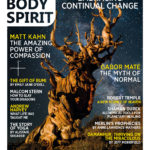by Dustin Grinnell
John Sarno, MD, a New York physician who passed away in 2017, pioneered the diagnosis of a condition called tension myoneural syndrome, or TMS—a psychosomatic syndrome in which repressed, unconscious emotions, most often anger, manifest as physical symptoms to distract the conscious mind from painful emotions.
Though it wasn’t widely accepted among the medical community, Dr. Sarno stood by his theory that most chronic pain conditions, including back or neck pain, fibromyalgia or carpal tunnel syndrome, and even some autoimmune disorders, aren’t physical problems but psychological ones, all under the umbrella of TMS.
He speculated that evolution had built into our brains tools to avoid dealing with stress below the level of conscious awareness. Developing physical symptoms, according to Dr. Sarno, served to distract us from unpleasant emotions. In Dr. Sarno’s rehabilitation practice, if a patient accepted that their pain had psychological roots, they would typically recover, even after years of doctor visits and countless interventions.
In his decades-long career treating patients with chronic back pain, Dr. Sarno found that individuals who developed TMS had similar personality characteristics. In his book The Mindbody Prescription, he wrote, “Deeply repressed feelings of inadequacy foster the development of personality traits that are almost universal to people with TMS. They tend to be perfectionistic, compulsive, highly conscientious, and ambitious; they are driven, self-critical, and generally successful. They also have a compulsion to please, be a good person, to be helpful and nonconfrontational. In short, people with TMS have a strong need for approval, whether it is love, admiration, or respect.” He writes that self-imposed pressures to please, to be a ‘good’ person, and to achieve cause inner conflict. The lingering child within each of us doesn’t want to be put under pressure. If pushed, that inner child can get sad and angry and cause pain.
Among those who have suffered from chronic back pain, Dr. Sarno is a cult figure, with a 90 percent success rate in curing chronic pain patients. In The Mindbody Prescription, he claims that, since 1973, he has seen about ten thousand patients who have been rendered pain-free. In 1999, John Stossel, then a journalist for ABC, hosted a 20/20 segment about Dr. Sarno’s work and his own back pain. High-profile figures who report being cured by Dr. Sarno’s work include radio talk show host Howard Stern and the creator of Seinfeld, Larry David. A filmmaker who has suffered from TMS his whole life recently made a documentary, All the Rage, which profiles Dr. Sarno and includes an interview with Larry David. David says that realizing his chronic arm pain was psychological, and not tendinitis, “was the closest thing I’ve ever had to a religious experience. And I wept.”
On Amazon.com, Dr. Sarno’s books have received thousands of reviews featuring stories of transformation. Many of these people had seen numerous doctors without success but say they were cured within weeks of reading his books, especially the best-selling book Healing Back Pain. Integrative physician Dr. Andrew Weil wrote in his book Spontaneous Healing that Dr. Sarno’s impressive record of clinical success was based on nothing more than talking to patients and enlightening them as to the true nature of their pain. Dr. Weil called Dr. Sarno equal parts doctor, scientist, and faith healer.
When Dr. Sarno began his career in rehabilitative medicine at New York State Rehabilitation Hospital over fifty years ago, many of his patients suffered from various pain syndromes and had received conventional treatments, such as physical therapy, without fully recovering. Most of his patients became stuck in cycles of pain management, which required regular office visits and endless treatments. Dr. Sarno became frustrated. He wasn’t addressing the root causes of his patients’ chronic pain. He became puzzled by the fact that chronic back pain was becoming an epidemic, growing at a rate of fourteen times that of population growth at that time.
He noticed that nearly all of his patients with chronic back pain had similar medical histories. In addition to their back pain, many suffered from conditions that were caused by psychological stress. Many suffered from chronic migraines, respiratory issues, such as asthma, or pet allergies. Others had irritable bowel syndrome or skin diseases like eczema. Were pain conditions, such as chronic lower back pain, caused by stress and tension, even emotional problems?
With this understanding in mind, Dr. Sarno began informing his patients that their back pain might be caused unconscious stress. After ruling out serious conditions like cancer, he would explain to his patients that their physical symptoms were trying to distract them from unpleasant emotions. Many of the patients who accepted that their back pain was largely psychological experienced a full recovery, even after years of doctor visits and countless interventions.
In Healing Back Pain, Dr. Sarno explains that, in most cases, pain wasn’t a structural issue, such as a herniated disc or disc degeneration. More than likely, it was caused by mild oxygen deprivation, brought about by the brain altering the blood flow to an area. If a person was ignoring unconscious anger, for example, their mind might distract them from the anger by depriving their lower back of oxygen. Tension myoneural syndrome isn’t recognized by mainstream medicine, yet tens of thousands of people have cured themselves of chronic pain just by acknowledging that their pain isn’t an anatomical or physiological problem but a psychosomatic one.
The cure for TMS is knowledge. It consists simply of reading Dr. Sarno’s books or, when he was alive, attending his Monday-night lectures or making an appointment with him. Exposing oneself to this knowledge would help reveal to the conscious mind the repressed negative emotions, such as sadness or anger, that was driving the pain. In Dr. Weil’s book Natural Health, Natural Medicine, he writes that “most people with chronic back pain go around thinking they have a bad back and that the trouble is there. In my experience, all chronic back (and neck) pain should be considered TMS until proven otherwise, and most therapeutic effort should be directed at your head: specifically, at changing your patterns of thinking, feeling, and handling stress that lead the nervous system into this abnormal pattern.”
Dr. Weil once experienced an episode of disabling back pain. After he accepted the emotional basis for the pain—the loss of two close relationships—his back pain disappeared in three weeks and never returned. After that, he recommended Dr. Sarno’s books to patients who had already tried every imaginable treatment for back pain.
Find out more:
Dustin Grinnell is a writer based in Boston. His essays and journalism have appeared in New Scientist, VICE, The LA Review of Books, and many other popular publications. He is the author of the sci-fi novels The Genius Dilemma and Without Limits. See more of his work:
www.dustingrinnell.com






